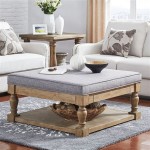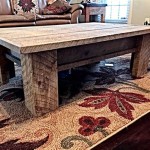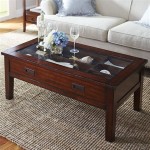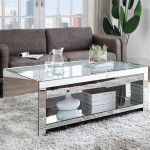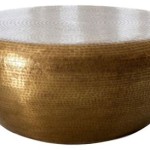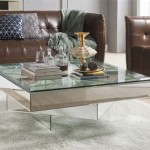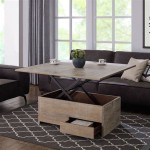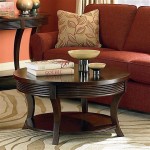How To Build A Round End Table
Constructing a round end table is a manageable woodworking project that can significantly enhance a living space. This article provides a comprehensive guide to the process, covering material selection, cutting techniques, assembly, and finishing. The instructions are designed for individuals with intermediate woodworking skills and access to standard woodworking tools.
Planning and Material Selection
The initial stage involves meticulous planning and careful material selection. The desired dimensions of the round end table dictate the quantity of materials required. A standard height for an end table ranges from 22 to 26 inches, but this can be adjusted to suit individual preferences and seating arrangements. The diameter of the tabletop is also a critical factor, typically ranging from 18 to 24 inches.
The choice of wood significantly impacts the table's aesthetic appeal and durability. Hardwoods like maple, oak, cherry, and walnut are popular choices due to their strength, beauty, and ability to accept finishes well. Softwoods like pine are more affordable but less resistant to scratches and dents. Consider the existing furniture in the room to select a wood that complements the overall decor.
For the tabletop, several options exist. A solid wood tabletop offers a classic look and can be created by gluing together several narrower boards to achieve the desired width. Alternatively, a plywood core can be veneered with a hardwood of choice, providing stability and minimizing warping. A butcher block tabletop provides a rustic aesthetic and robust surface. The legs can be constructed from solid wood, metal, or even repurposed materials, depending on the desired style.
Beyond the wood itself, other materials are necessary. Wood glue is essential for bonding pieces together. Screws are required for added strength, particularly when attaching the legs. Sandpaper in various grits (from coarse to fine) is needed for smoothing surfaces before finishing. Finally, a finish, such as varnish, lacquer, or oil, is required to protect the wood and enhance its natural beauty.
Cutting and Shaping the Tabletop
Creating a perfectly round tabletop requires precision and careful execution. If using solid wood, begin by selecting boards that are free from knots and other imperfections. These boards must be planed to a consistent thickness and then joined edge-to-edge to create a larger panel. Use wood glue and clamps to tightly secure the boards, ensuring a seamless joint.
Once the glue has dried completely, the panel is ready to be shaped into a circle. There are several methods for achieving this. A simple approach involves using a compass to draw a circle on the panel, matching the desired diameter. A more precise method involves creating a jig for a router. This jig consists of a base with a pivot point in the center and an arm that holds the router. As the router is rotated around the pivot point, it cuts a perfect circle.
Regardless of the method used, it is crucial to cut slowly and carefully to avoid splintering the wood. After the initial cut, refine the edge with a sander. A belt sander is effective for removing larger imperfections, while an orbital sander is ideal for achieving a smooth, even surface. Progress through progressively finer grits of sandpaper, starting with 80-grit and ending with 220-grit.
If using plywood with veneer, the same circular cutting techniques apply. However, extra care is needed to avoid chipping or damaging the veneer. Use a sharp blade and apply masking tape along the cut line to prevent tear-out. After cutting, gently sand the edges to smooth them and remove any sharp corners.
For butcher block tabletops, the cutting and sanding process is similar to solid wood. However, due to the end-grain construction of butcher block, more sanding may be required to achieve a smooth, even surface. Consider applying a food-safe finish to butcher block tabletops, particularly if they will be used for food preparation.
Designing and Attaching the Legs
The design of the table legs significantly affects the overall style of the end table. Straight, tapered legs offer a classic and elegant look. Splayed legs, angled outwards, provide a mid-century modern aesthetic. Turned legs, created on a lathe, add a touch of traditional craftsmanship. Metal legs, either straight or hairpin-style, can create an industrial or contemporary feel.
When choosing leg material, consider the weight and stability of the tabletop. Solid wood legs should be dimensioned to provide adequate support. Metal legs should be sturdy and properly attached to the tabletop. Regardless of the material used, ensure all legs are the same length to prevent the table from wobbling.
Attaching the legs securely is crucial for the structural integrity of the table. One common method involves using aprons, which are pieces of wood that connect the legs to the tabletop. The aprons are attached to the underside of the tabletop with screws and glue. The legs are then attached to the aprons, also with screws and glue. This creates a strong and stable connection.
Another method involves using metal mounting plates. These plates are attached to the underside of the tabletop with screws. The legs are then screwed into the mounting plates. This method is particularly suitable for metal legs or legs with a pre-drilled mounting system.
When attaching the legs, ensure they are positioned evenly around the tabletop. Use a measuring tape to accurately space the legs and ensure they are aligned properly. Use a level to verify that the legs are perpendicular to the tabletop. After attaching the legs, test the table for stability. If any wobble is detected, shim the legs as needed.
Sanding and Finishing
Sanding is a critical step in preparing the end table for finishing. It removes imperfections, smooths the surface, and creates a uniform texture that allows the finish to adhere properly. Begin with a coarser grit sandpaper (80-grit or 100-grit) to remove any scratches or blemishes. Then, progress through progressively finer grits, such as 150-grit, 180-grit, and 220-grit.
When sanding, work with the grain of the wood to avoid creating scratches. Use a sanding block or orbital sander to ensure even pressure and consistent results. Pay particular attention to edges and corners, as these areas are prone to splintering or damage. After sanding, remove all dust with a vacuum cleaner or tack cloth.
The choice of finish depends on the desired look and level of protection. Varnish is a durable and water-resistant finish that provides a glossy or satin sheen. Lacquer is a fast-drying finish that is also very durable. Oil finishes, such as tung oil or linseed oil, penetrate the wood and enhance its natural beauty. Water-based finishes are low in VOCs and provide a more environmentally friendly option.
Before applying the finish, test it on a scrap piece of wood to ensure it produces the desired result. Apply the finish in thin, even coats, following the manufacturer's instructions. Allow each coat to dry completely before applying the next. Lightly sand between coats with fine-grit sandpaper to remove any imperfections.
After applying the final coat of finish, allow it to cure completely before using the end table. This may take several days or even weeks, depending on the type of finish used. Once the finish is cured, the end table is ready to be placed in the desired location and enjoyed.
Additional Considerations and Customization
Several customization options can be incorporated into the end table design to enhance its functionality and aesthetic appeal. A shelf can be added beneath the tabletop to provide additional storage space. This shelf can be constructed from solid wood, plywood, or even glass.
Drawers can be integrated into the end table to create a hidden storage compartment. This requires more advanced woodworking skills but can significantly increase the table's functionality. Consider using dovetail joints or other strong joinery techniques to ensure the drawers are sturdy and durable.
Inlays can be added to the tabletop to create a unique and decorative design. These inlays can be made from contrasting woods, metal, or even stone. Routing out the inlay area with a carving tool or precise router templates is usually required.
The legs can be customized with decorative details, such as carvings, fluting, or metal accents. Experiment with different leg shapes and sizes to achieve the desired look. Consider using hairpin legs to create a mid-century modern aesthetic or turned legs to add a touch of traditional craftsmanship.
When customizing the end table, always consider the overall design and ensure that the modifications complement the existing style. Avoid adding too many details, as this can make the table look cluttered and overwhelming. The goal is to create a functional and aesthetically pleasing piece of furniture that enhances the living space.

Simple Round Side Table Kreg Tool

Diy End Table Angela Marie Made

Diy Round Side Table Shanty 2 Chic

Build A Round Side Table Basic

Build A Round Side Table Basic

Diy Wood Circle Side Table Liz Marie Blog

Easy Diy Round End Table

Diy Pedestal Accent Table Remodelaholic

Make A Round Side Table With Gary Rogowski Finewoodworking

Diy Round Side Table Plans Pine And Poplar
Related Posts

